1890 Map showing Blackwell's Park
The land that would become the Durham site of Trinity College, later East Campus of Duke University, is first noted in Durham history as a horse racing track and occasional fairgrounds, known as Blackwell's Park. The 67.5 acres was acquired by James W. Blackwell in 1880-1 from Archibald Nichols and developed as a racetrack. By 1886, JW Blackwell had given up ownership to his brother WT Blackwell, of Blackwell's Bull Durham Tobacco Company. Blackwell was bankrupt by 1888 due to the failure of his Bank of Durham; whether he sold it to Julian Carr or Carr took the land as payment for debt is unknown.
The Park was described by the News and Observer in 1890:
"The Blackwell Park at Durham, where Trinity College will be located, is one of the finest pieces of property in the State. I had no idea what a magnificent site and fine grounds the college had until Brother B.N. Duke took me over them. There is 62 1/2 acres upon which $40,000 has been expended in improvements of various kinds. There are a number of neat cottages scattered around over the grounds, four fine wells of water, a large building used as a grandstand, and a fine drive made for a track to try the speed of horses, and within this circle is the finest grounds for athletic sports to be found anywhere. There is a fine orchard on the grounds, and grape vineyard, a large stable (two of them), and a hennery. In fact, there is every appliance for a truck and dairy farm. Then there is a grove of young oaks, large enough to make an excellent shade, on another part of the grounds."
In the 'Carr-washing' of Duke and Durham that seems a progressive trend in the popular history of our city (i.e. "Durham: A Self-Portrait",) Carr's role in bringing Trinity College to Durham has sometimes been minimized or forgotten.
Carr had become a financial supporter of Randolph County's struggling Trinity College a few years prior to the point at which he acquired Blackwell Park; he began supporting the college with two other trustees ( 1855 Trinity Alumnus and banker Colonel John Wesley Alspaugh and James A. Gray, another Winston-Salem banker) in 1885. In 1887 he gave the college $10,000 in securities as an endowment to keep it afloat. His initial association with the college seems to have come about through the rather incredible story of his relationship with Soong Yao-ju, otherwise known as 'Charlie Soon'. That story deserves its own telling on this site, but not here. After becoming Soong's patron, and paying his way to Trinity, Carr seems to have increased his support of the struggling college.
Trinity College had arisen from Brown's Schoolhouse, a small 16 x 20 ft log cabin in Randolph County, established around 1830. Brantley York, a Methodist preacher, became head of the schoolhouse in 1837. He moved the school to a new, larger building "some distance from the old [one]." In 1840, the school was enlarged and renamed the Union Institute, and in 1841, it incorporated and became the Union Institute Academy. It became well known under the leadership of Braxton Craven, who headed the school after 1842, and a town, named Trinity, NC, grew around the school. In 1851, the Union Institute Academy was incorporated as Normal College, a state teachers' college. In 1853, the college received funding from the state and was empowered to grant other, more general, college degrees. Curricula included "preparatory, classical collegiate, and English."
In 1855, a single, all-purpose brick masonry structure was built to house the college, and the next year the school was 'adopted' by the Methodists. The college no longer focused on teacher education and expanded its liberal arts curriculum. One of the trustees, R. T. Heflin, suggested that the college’s name be changed to Caswell, in honor of Governor Richard Caswell, a Revolutionary War hero and devout Methodist. However, when the charter was amended in 1859, the institution changed its name to Trinity College, in honor of the institution in Cambridge, England. Braxton Craven was named first president of Trinity. The school briefly closed its doors in 1864, under occupation by Union troops, but Craven returned to re-open the school in January 1866. The main building was expanded between 1872-1874 with a wing that fronting the road which is now NC62. The new wing set at a cross-angle to the 1855, forming a T. The new wing contained classrooms and a chapel.
Trinity College, Trinity, NC.
Craven remained president of the school until his death in November 1882.
See the original site of Trinity College in Trinity, NC on a Google Map
Carr became chairman of the search committee seeking a new president for the college, and played a strong role in the eventual choice of John Franklin Crowell. Although Crowell's northern heritage and Yale degree would seem at odds with Carr's southern proclivity and the situation of the college, Carr had high aspirations for the institution, and Crowell came highly recommended by Carr's good friend at the University of North Carolina, Horace Williams, despite the fact that Crowell was only 29. (Williams and Crowell were classmates at Yale.) Although the secondary sources suggest that Carr was initially against Crowell's later desire to move the school to a more urban location, I rather doubt that the savvy Carr didn't foresee this.
The Methodist Conference agreed at its 1887 convention to endorse relocation of the college. They concluded that the cost of the move, new site, and erection of a new building would be $20,500.
Crowell began to solicit interest from various North Carolina cities; Raleigh offered the school $35,000 for the move to a location currently occupied by NC State, and the Methodist Conference approved the move to Raleigh.
Durham - having lost the Baptist's Female Seminary (later Meredith College) to Raleigh despite offering more money - and wounded by the disdain with which the Seminary and Baptists had regarded "pushy little" Durham, calling it "no fit place for innocent girls to abide in" - would not go easily into the good night. The story of how Carr and the Dukes came together to bring Trinity to Durham seems to vary in every account, but clearly the tobacco rivals either saw this as an important opportunity which transcended their competition, or neither wanted to be outdone by the other - or both.
The one thing the Carr and the Dukes had in common was that they were easily the most prominent, and richest, Methodists in Durham (if not a much larger geographic area.) Robert Bumpas, minister of the Main Street Methodist Church, built by the Dukes, and EA Yates, presiding elder of the Durham District of the Methodist Conference, implored the Washington Duke to intervene on Durham's behalf.
Jean Anderson, quotes Bumpas' recollection, written to Ben Duke in 1898:
"I have thought of the day I went to your house after dinner and found you lying on the lounge in the hall, and you told me you were thinking of buying [Blackwell] Park and building an orphanage for the Methodist Church [on the site]. When I suggested that you have Trinity College moved to Durham, you agreed to consider the matter."
Per the Duke Archives and Robert Durden:
When Washington Duke's former pastor and then District Superintendent E. A. Yates told Duke of Raleigh's offer Duke casually remarked that Durham could match that and add $50,000 for endowment. Yates inquired if he could wire Crowell such an offer and immediately the college president was in Durham personally meeting Washington Duke for the first time. With a pledge from Duke of $85,000 in hand, Yates and Crowell hurried across town to ask their friend Julian S. Carr, long-time trustee and the largest benefactor of the college to date, if he would donate as a site the fair ground he owned on the western edge of the city. Carr agreed without hesitation, conveying to Washington Duke, 'I shall ever feel proud to point to you as a fellow townsman..."
When called to meet in Durham on March 20, 1890, the trustees accepted the offers from Duke and Carr with gratitude. The formal offer from Duke was signed by Washington but written by Benjamin. As further inducement, citizens from Durham presented a check for $9,361 for endowment and the trustees enthusiastically proclaimed that with Duke's gift for endowment and a building, funds were ample for a solid beginning. Upon request a committee from Raleigh relinquished its claim and the Christian Advocate, the official organ of the church, proclaimed, 'All Methodists could write the address Trinity College, Durham, North Carolina with pride.'
Crowell referred to the move as "placing the college upon the highway to success in the service of humanity."
Planning soon began to erect buildings on the former park and racetrack. Washington Duke headed the building committee, but Ben Duke bore most of the responsibility for his aging father. The original campus consisted of three campus buildings: the College (Main Building,) College Inn, and the Technological Building, which also contained the generator for the campus. The college also constructed five houses for professors just to the south of the College Inn, collectively known as Faculty Row. Some accounts refer to a sixth house on campus that was existing and renovated - this may have been the Edwards/Robertson house (who lived in the house or what its use was earlier is not clear.)
When the Main Building was near completion in August 1891, the central tower collapsed The building needed to be rebuilt, and Trinity's move to Durham was delayed for a year.
Finally, on October 12, 1892, the opening of the college occurred:
"Trinity dedication will take place on Wednesday, October 12. The first feature of the day's program, set for 10 o' clock at Main Street Methodist Church will be the dedicatory sermon by Dr. E.E. Hass of the Christian Advocate, Nashville, Tenn. At 2:30 pm, a procession of municipal authorities and civic and military organizations will be formed in front of the post office and march to the main entrance to Trinity Park. [Changes in plans were made which appeared in a later Issue of the newspaper. The courthouse was named as the point for the formation of the procession and J .S. Burch was announced as the chief marshal.]
"On arrival at Trinity Park, the procession will be met by the trustees, faculty and students of the college. An address of welcome to the college will be delivered by Capt. E.J. Parrish on behalf of the mayor (M.A. Angier) and the people of Durham. This will be responded to by President Crowell, on the topic 'The Relation of the College to the Life of the People.' A formal transfer of the buildings and grounds to the board of trustees will be In the following order.
The main college and Inn by Washington Duke.
Trinity Park by J.S. Carr.
The technological building by President Crowell.
The furniture by Dr. F.L. Reid.
The dedicatory address by Rev. Dr. E.A. Yates.
Prayer by John R. Brooks.
Doxology.
Benedictation
All school authorities and the schools of the town are expected to participate. All benevolent organizations are invited to attend."
The Issue of the Globe three days later reported that "Everything at the college Is being put into readiness for the dedication Wednesday. Dr. E.L.. Reid, who did so much towards raising, money to furnish the several buildings spent two days here this week and the result is two elegantly appointed parlors, one In the main building and the other the college inn, parlors In keeping with the handsome exteriors and such as great institutions, like new Trinity, must have In order to compete. "The furniture in the former was donated by Messrs. Hanes brothers of Winston in memory of their father who lived In Davie County. It is a beautiful room and a fitting memorial of a good man. The fitting of the latter was made possible through the generosity of friends of Dr. Reid, and also a memorial room, it being in the memorial of Dr. Reid's, father, Rev. N.F. Reid.
Trinity opened its doors in Durham in the Fall of 1892 with an enrollment of 180 men, budgeted expenses were $17,900 for the year, and anticipated tuition revenue of $4500, with $2300 still owed from the previous term. The Dukes supported the college, and became increasingly angry at the lack of financial support for the college from their fellow Methodists of NC. They supplied $7500 a year for the first three years if the college could raise an additional $15,000 per year.
While this would not be the end of the financial strain for the college, it allowed Trinity College, Durham to stay open during its first semester with some relief of the pressure of meeting its obligations.
1891 Bird's Eye from downtown, showing the main buildings of Trinity College and a smattering of small frame structures.
The main entrance of the college was located on the south side of the former park, on West Main St. A set of iron archways framed the entrance, with the vista terminated by the Main Building, later known as Old Main/the Washington Duke Building.
Trinity College entrance, looking north from West Main, 1904.
Trinity College entrance, looking north from West Main, 1904.
Location of the original entrance to Trinity College in Durham, 08.16.10
Back in Randolph County, the old college buildings were turned into a private college preparatory school, which became a public school in the early 20th century. In 1924 a special school tax district was established in Trinity and a new elementary school and high school building was built on the site of the college. That was in turn torn down in 1981, and the historic site is now a parking lot. The only remnants of the college - a gazebo and school bell are squeezed between NC 62 and the fence around the lot.

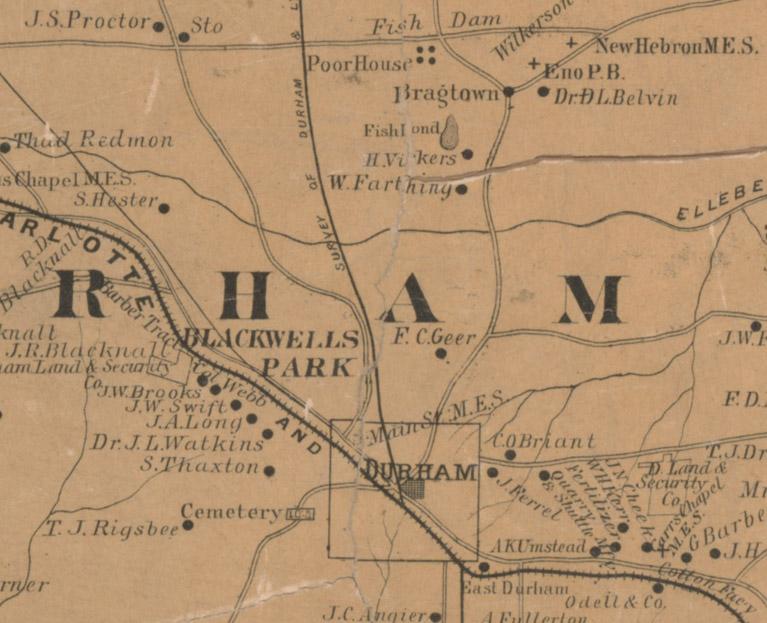
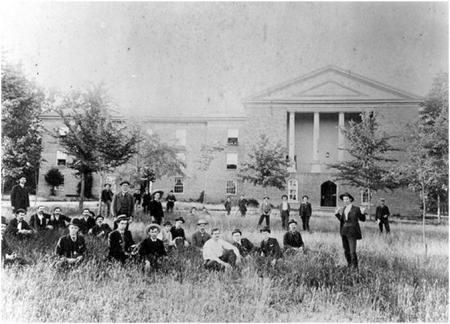


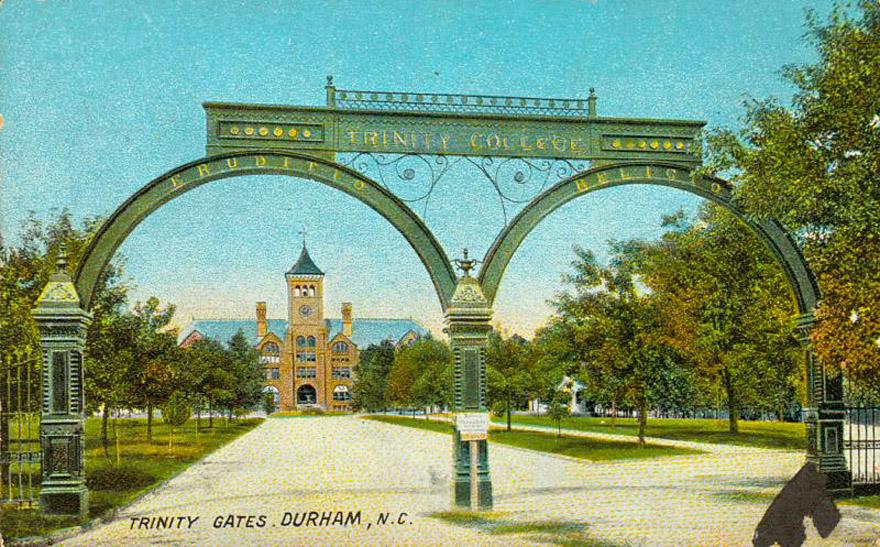
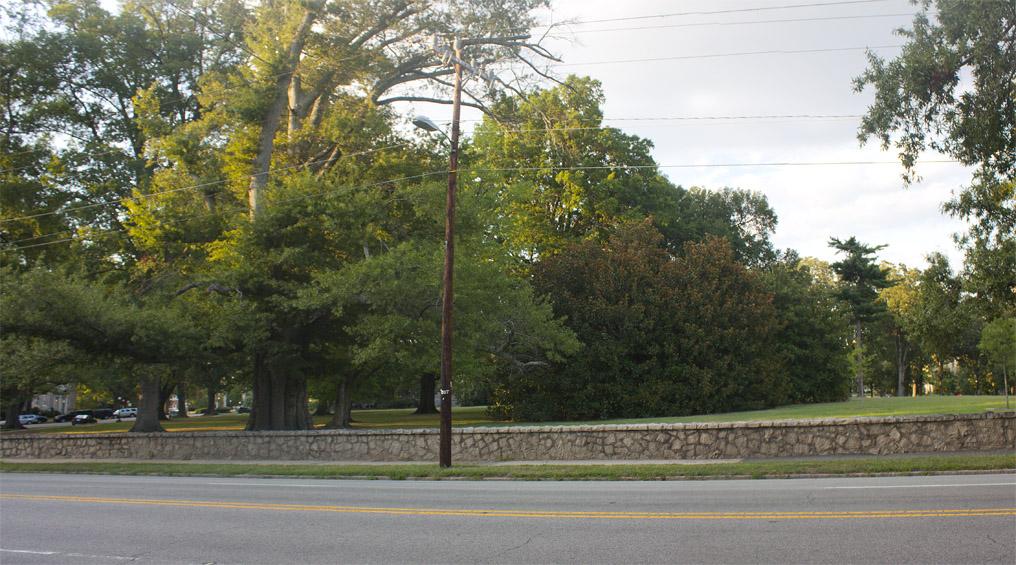
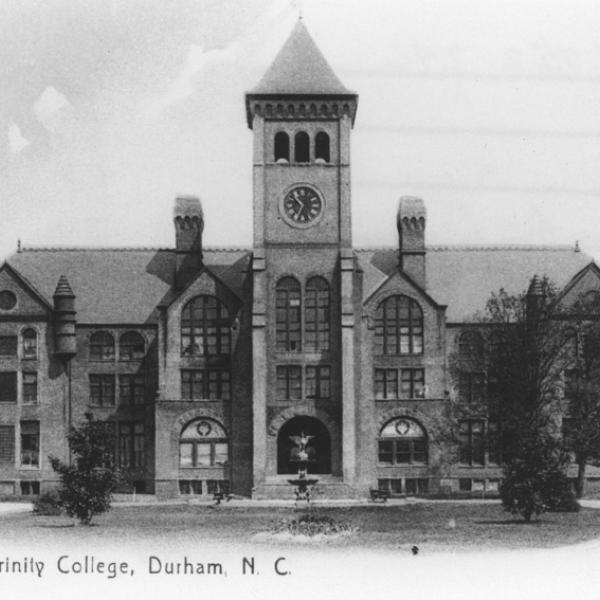
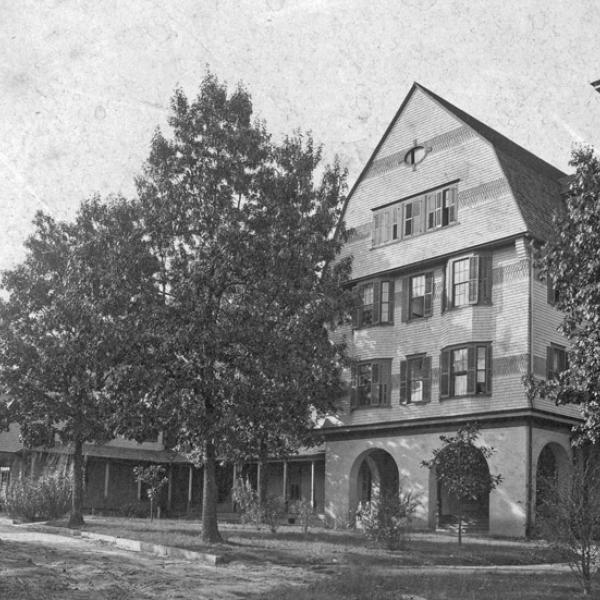
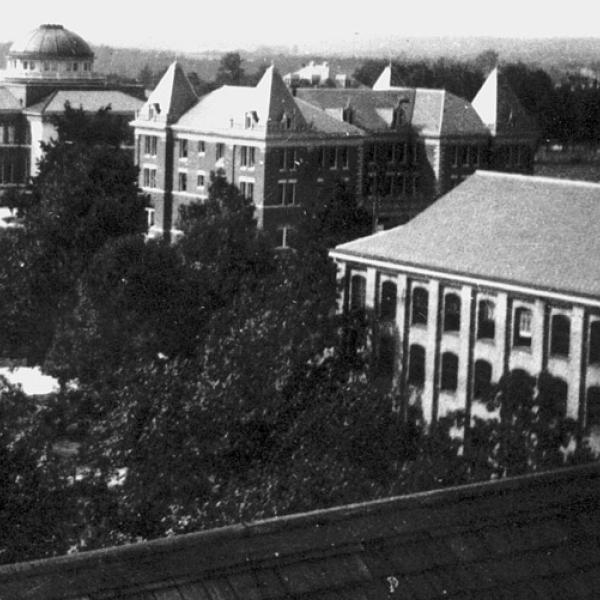
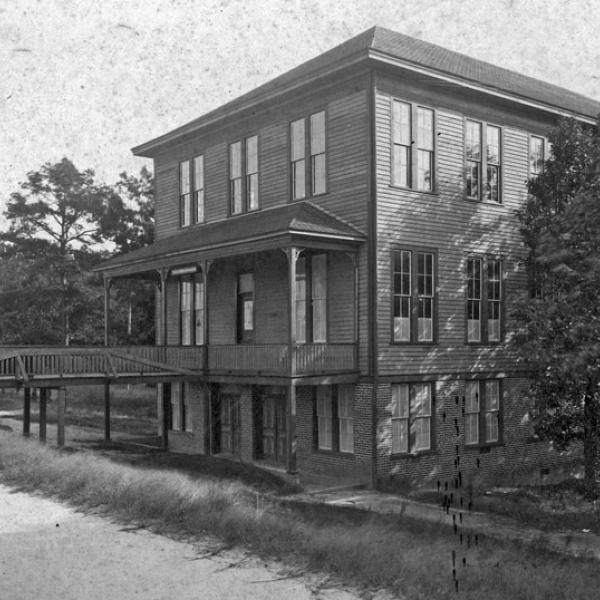
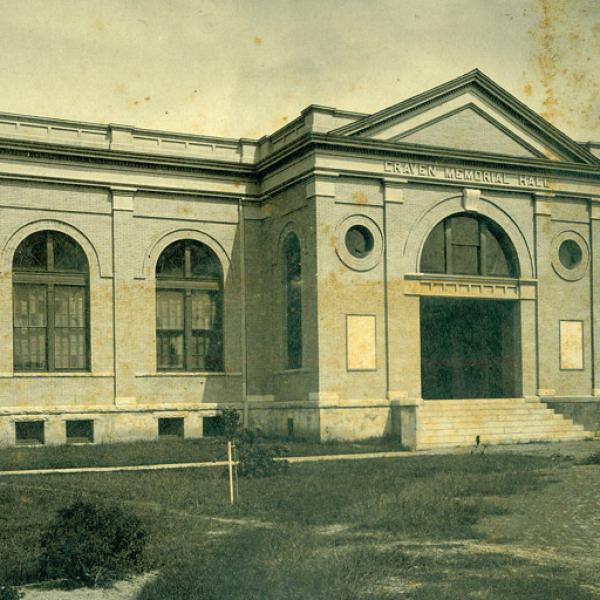



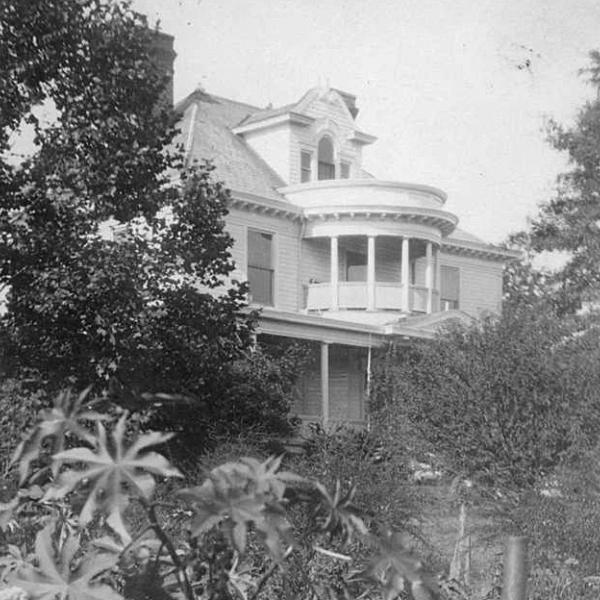
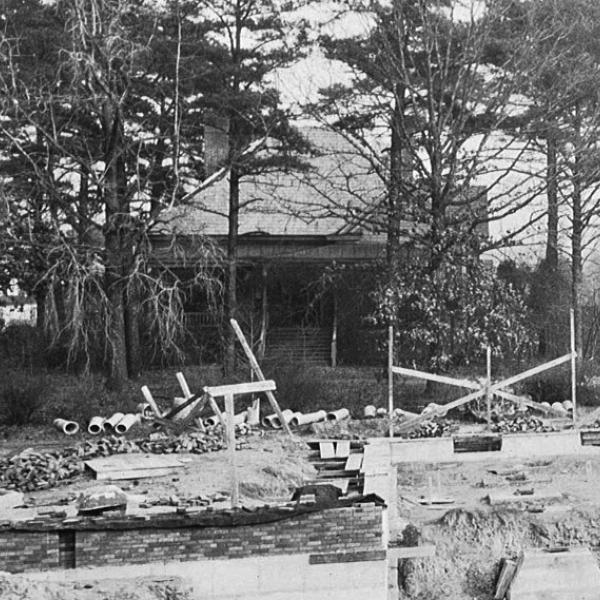
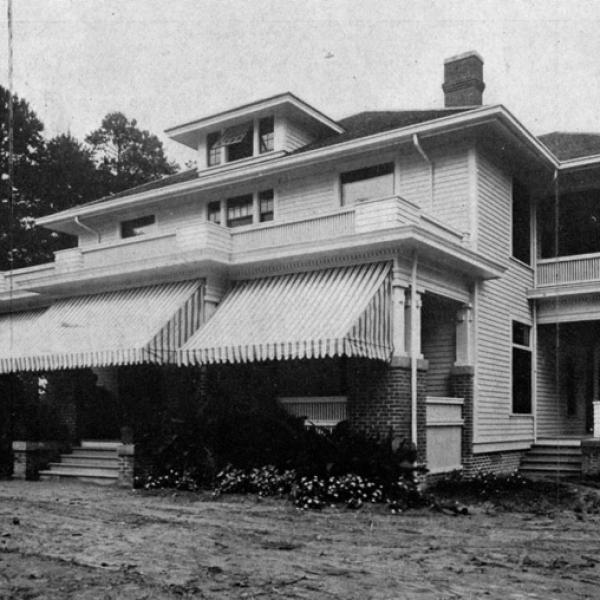
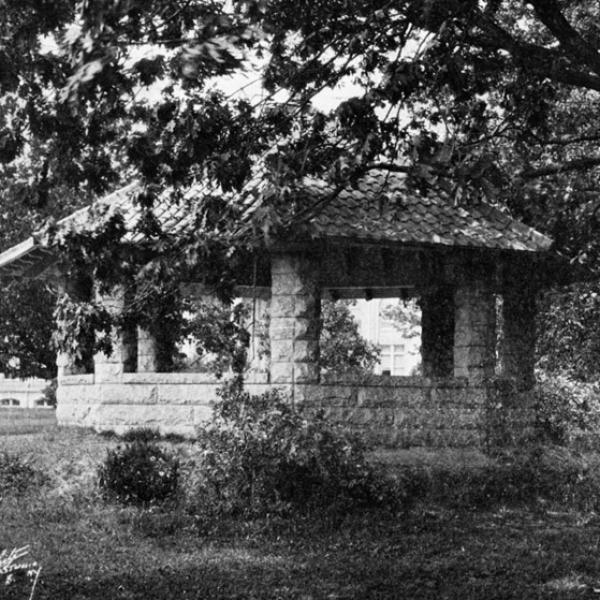


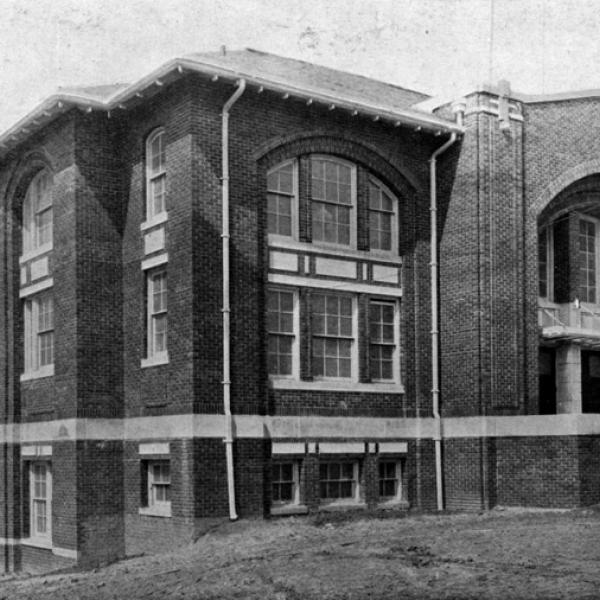
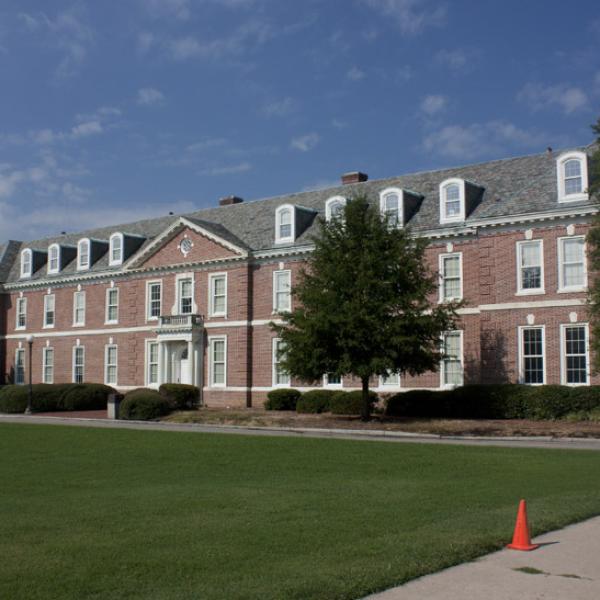
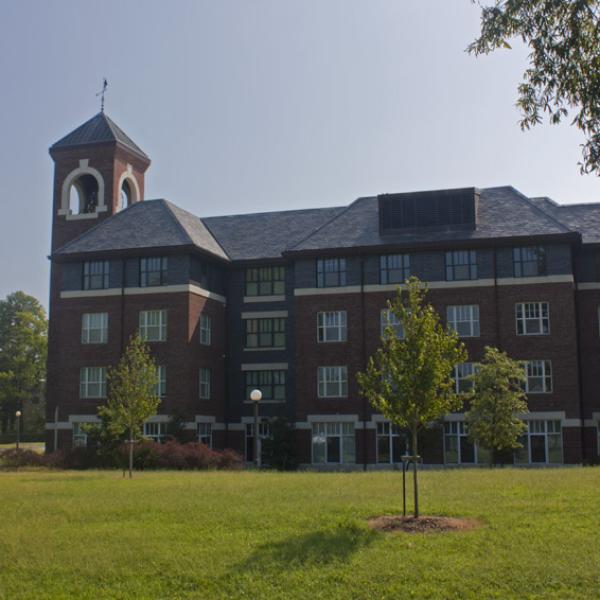
Add new comment
Log in or register to post comments.